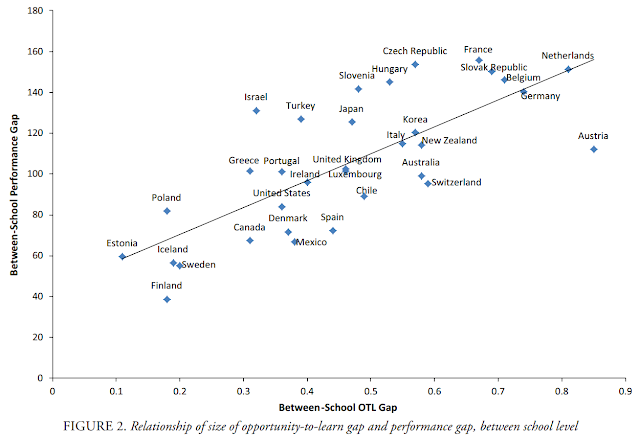Are We Teaching Poor Children Less Math?
Obviously, there is inequity in society. If such inequity also exists in education then the effects of poverty in schools are likely to be magnified. This unequal treatment can in fact start at the curriculum level. Children from affluent families can be given access to a richer and deeper instruction while those from poor families are provided less. This may sometimes happen in differentiated instruction, but is nearly guaranteed to manifest in academic tracking. Differentiated instruction often aims at addressing the needs of a student thereby alleviating inequity. On the other hand, academic tracking is deciding the content and skills to be taught based on a perceived ability of a student. Students from poor families usually have weaker background preventing them to qualify for higher academic tracks.
The Opportunity To Learn (OTL) can be quantitatively measured by examining the curriculum. This factor is separate from resources such as learning materials, teachers and infrastructure. Yet, OTL alone has been shown to correlate strongly with gaps in performance. Schmidt and coworkers have recently examined the data from PISA 2012 to measure how access to content relates to academic achievement. Their findings are summarized in a graph they provide in the journal Educational Researcher:
Washington Post quotes one of the authors of the study, William H. Schmidt:
The Opportunity To Learn (OTL) can be quantitatively measured by examining the curriculum. This factor is separate from resources such as learning materials, teachers and infrastructure. Yet, OTL alone has been shown to correlate strongly with gaps in performance. Schmidt and coworkers have recently examined the data from PISA 2012 to measure how access to content relates to academic achievement. Their findings are summarized in a graph they provide in the journal Educational Researcher:
Washington Post quotes one of the authors of the study, William H. Schmidt:
“There’s a certain amount of tracking that still goes on. A lot of it is what I call shell games. If you look at transcripts, you’ll see a school offers 10 different kinds of Algebra classes — Algebra 1, Algebra A, B and C and so on. And a parent thinks, ‘Oh, my kid is doing fine, he’s taking Algebra.’ But upon closer examination, that student is getting something different. And it’s showing up in our analysis quite strongly.”Interestingly, there is another study that has been recently published in another journal from the American Educational Research Association. The paper, "Opportunities for Learning Math in Elementary School: Implications for SES Disparities in Procedural and Conceptual Math Skills", published in the American Educational Research Journal shows that such inequity in curriculum does not exist in elementary schools. The following is an excerpt from the study's conclusions:
However, in the current analysis from a large, multisite sample of third- and fifth-grade classroom observations, low SES children were receiving comparable, if not higher, amounts of math and science instruction than their middle- to higher-SES classmates. It is unclear whether these differences in findings across studies are due to differences in grades, sample demographics, and/or data sources (teacher report vs. observation) since there is a lack of available evidence in the extant literature that examines SES disparities in opportunities to learn math during late elementary school. However, the descriptive data from this study did not point to wide disparities in formal learning opportunities between lower and higher SES children despite persistent achievement gaps.One must keep in mind, however, that the comparisons made so far in both studies are limited to Opportunities To Learn. Additional inequities can arise from the quality of teachers, learning materials, and school climate. What is seen clearly here, by simply examining the curriculum, is that schools in the United States are actually not reducing but exacerbating social inequality. The situation is only worse in the Philippines where academic tracking is not frowned upon but mandated as a feature of the new DepEd K to 12 curriculum.

Comments
Post a Comment